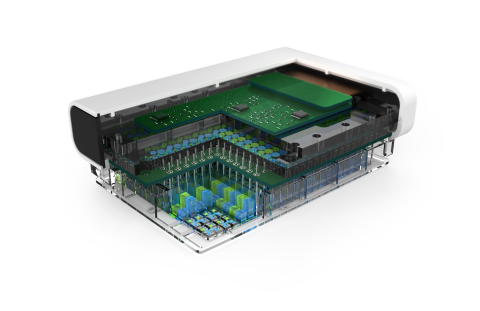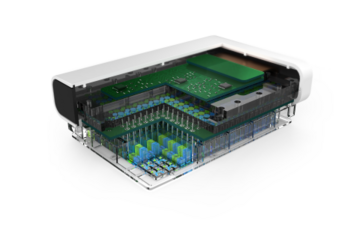Draper Delivers First Lung-on-Chip Model to Predict Response to COVID Antiviral Treatments
CAMBRIDGE, MA—As society recovers from the COVID-19 pandemic and prepares for the next one, the challenge of accelerating the development of therapies to meet the needs of a diverse population looms large. Now, a new study by Draper is poised to accelerate development of drugs against emerging diseases such as COVID-19 by integrating a toolset that uses human tissue models based on organ-on-chip technology and the expertise of microbiologists and bioengineers operating the model systems in a high-containment laboratory.
In the study, researchers conducted experiments where they grew microscale tissue models of the lung in precision-engineered multiwell plates, infected the models with the SARS-CoV-2 virus and treated the tissues with one of three FDA-approved antiviral therapeutics. They used multiple measures of infection, analyzing some 3,000 data points, to identify the antivirals that effectively blocked viral replication in the lung tissue models. The study, published in the online preprint server bioRxiv, demonstrates that Draper has built the first model of the human lung capable of assessing the efficacy of SARS-CoV-2 therapeutics in a high-throughput system.
The study is significant, according to the researchers, because it shows the PREDICT96-ALI (air-liquid-interface) platform accurately predicted the clinical efficacy of three SARS-CoV-2 therapeutics: Lagevrio™ (molnupiravir), Paxlovid™ (nirmatrelvir and ritonavir) and Veklury® (remdesivir). The preclinical model provided data that was predictive of human clinical responses as measured by hospitalization rates of COVID-19 patients treated with the same antiviral therapies.
The study highlights the power of using 3-D, complex human tissue models rather than existing techniques such as animal testing or overly simplistic human or animal cell culture models that do not accurately mimic infection or drug responses in humans.
Christine Fisher, Ph.D., a co-author of the paper, says the study addresses current gaps in drug discovery and development. “A major limiting factor in the development of antiviral treatments for COVID-19 and other respiratory viral infections such as influenza is a lack of preclinical models capable of providing data predictive of human clinical responses at large scale. Draper’s PREDICT96-ALI allows researchers, who require human-equivalent efficacy data, to rapidly test drug candidates across diverse patient populations simultaneously,” Fisher said.
Ashley Gard, corresponding author of the study, says human tissue models sustained for weeks in a high-throughput, sensor-instrumented, 96-well dynamic microenvironment enable researchers to investigate multiple experimental conditions and obtain rapid and statistically significant results as they screen, evaluate and develop therapies.
“At Draper, we have created a predictive, preclinical tissue model of individuals impacted by serious respiratory diseases like COVID-19. These systems can model the human response to SARS-CoV-2 and other infectious diseases,” Gard said. “Having demonstrated the capabilities of Draper’s instrumented lung-on-a-chip system, PREDICT96-ALI, with its controlled microenvironment and unique lung tissue composition, we are able to address major gaps in the drug discovery and development process. This has the potential to change the lives of patients facing infection with SARS-CoV-2 and other emerging high-threat pathogens.”
Results of the study build upon Draper’s 2021 study that documented the first SARS-CoV-2 infection and viral replication in a human tissue lung-on-a-chip. The earlier research was published in Scientific Reports.
PREDICT96 is a high-throughput, instrumented organ-on-a-chip microenvironment that serves as a drug development and testing platform for pharmaceutical companies, government agencies and academic researchers. The device is currently being used by Draper and its partners to develop and validate individual tissue models of gut, intestine, lung, liver, vasculature, kidney, blood brain barrier, tumor and gingival tissue and to evaluate immune-oncology approaches.
Key features of an organ-on-chip model that can be applied in screening therapies include the fidelity of the model in recapitulating human organ composition and function (including patient-to-patient variability across diverse donors), sufficient throughput to provide statistically significant data across multiple conditions in a standardized format (such as a microplate), compatibility with powerful, multiplexable and complementary readouts and suitability for operation in a BSL-3 high-containment environments.
In future studies, PREDICT96-ALI’s throughput and reproducibility can be applied to antiviral drug screening on diverse patient populations to yield insights on individual responses to candidate drugs, the researchers said.
The PREDICT96-ALI findings are based on research by Draper principal investigators Gard, Fisher, Jeffrey Borenstein and others.
Released June 14, 2022

